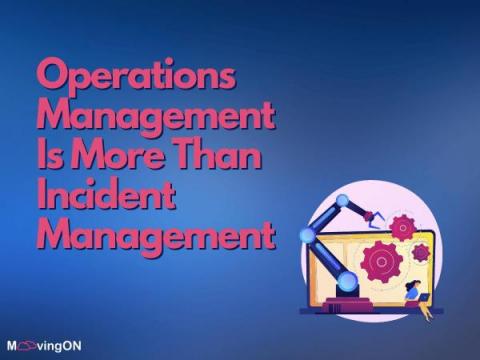Operations | Monitoring | ITSM | DevOps | Cloud
Incident Management
The latest News and Information on Incident Management, On-Call, Incident Response and related technologies.
Getting Amazon GuardDuty alerts via SNS Endpoint
Operations Management Is More Than Incident Management
To many, incident management and operations management may seem similar though they differ significantly. This difference, which lies in their end goals, also suggests that operations management is much more than incident management. To better understand why, it helps to look at the purpose of each one.
Season's Freezings: Automated Diagnostics with Jake Cohen
Incident Management for Digital Service Providers
Digital service providers (DSP) are valued for their ability to provide access to digital content on demand. A high-quality customer experience and instant access to digital services are the greatest expectations of consumers and vital aspects of successful DSPs. Therefore, it's crucial that incidents, when they occur, don't impact your operations. With a robust incident management strategy, DSPs can provide their teams with tools for automating, coordinating, and quickly resolving issues without-or with minimal-service interruptions.
Webinar: 2023 ITOps budgeting to win: use new research-based outage cost data
It’s no secret that the digital transformation essentially broke IT operations. With the rise in technology came a rise in outages capable of bringing organizations to a screeching halt. Those outages are expensive, and for years, the same number was thrown around as the authority on how much an outage cost (around $5,600 per minute). This number took off and was used in presentations, sales decks and other resources for years. But how could this number have stayed the same year over year?
Maximize efficiency with Terraformer: Manage Squadcast resources via IaC
Automation Seasons Freezings Wrap Up and New Year's Resolutions
It’s that time of year where you may feel pressured to pick your New Year’s resolutions. Well, we went ahead and tried to give you a head start. 2023 is the year we tame toil so we can focus on the fun stuff like engineering and innovation. Hopefully you have had the chance to follow along with us for the month of December for Seasons Freezings, the time of year you are locked out of production, so you have time to explore new ideas like automation 🙂.
You really like us: customer trust wins FireHydrant 3 G2 awards
FireHydrant received three G2 Winter 2023 awards — High Performer, a High Performer in the Enterprise category, and a High Performer in the United Kingdom. We are honored to be recognized by G2 because these awards are based on customer reviews.
Alarm optimization - what SIGNL4 has to offer
Having all relevant information pertaining to a critical incident is vital for quickly identifying the issue and prioritize its importance. SIGNL4 optimizes the perception, response and handling of incidents through customizable alerts with enriched parameters, images, sounds files, links to tickets or PDFs, as well as maps with geo-location information.











